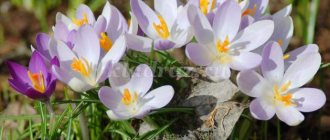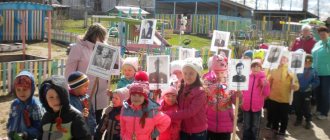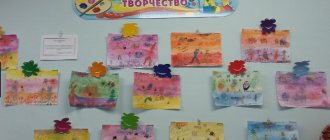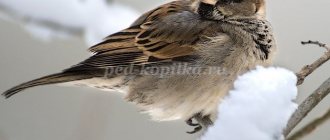Program content: 1. Clarify and consolidate children’s ideas about the changes occurring in nature in the spring. 2. Fix the signs of spring, the names of the spring months. 3. Foster a caring attitude towards the environment. 4. Activate the dictionary on the topic “Spring”. Preliminary work: learning the poem “Spring is Coming to Us” by I. Tokmakova, observations on walks, looking at paintings and illustrations about spring.
Equipment: • TV, VCR, video cassette “Seasons”, • “portraits” of the spring months; • pictures: flowers – coltsfoot, dandelion, dream grass, primrose, violet; animals – bear, fox, hare, wolf, squirrel; birds - starling, cuckoo, stork, swallow, rook, crane; • insect toys: beetle, fly, grasshopper, bee, ant, butterfly; • an envelope with cards for each child with a picture of a butterfly silhouette for coloring, colored pencils.
Methodological techniques: questions, looking at pictures, watching a video, games, reading poetry, a surprise moment, visual activity
Vocabulary: primrose, drops, thawed patch, birdhouse, early, late, names of young animals and birds.
Progress of the lesson: The teacher invites the children to watch an excerpt from the video film “Seasons” (about spring). Then one of the children reads a riddle poem: It gets light early in the morning, Thaws are here and there. The stream roars like a waterfall. Starlings fly to the birdhouse. Drops are ringing under the roofs, The bear got up from the snowy bed. The sun caresses everyone with warmth. Who knows this time of year?
— How did you guess that it was spring? What signs are mentioned in the poem? What signs of spring did you notice in the video excerpt? What time of year is it now? Why do you think so? - Spring has come. Let's remember what time of year it was before spring? Will there be after? — Each season consists of three months. Let's remember the names of the spring months. (March April May). What month is it? - You know that spring can be early, there can be mid-spring and late spring. What month do you think spring is in? Now we will look at the pictures and try to determine what period of spring they belong to. Why do you think so? (Children come to the table, take turns taking pictures that depict different periods of spring, name them and explain why they think so). — Changes also occur in the lives of animals in the spring. (Look at pictures with images of animals and tell: in the spring animals have babies, winter wool is replaced by summer wool). Birds: stork, cuckoo, swallow, starling, rook return from warm countries, build nests, lay eggs and hatch them. — In spring, the first flowers appear, and you have to find out which ones yourself. Now we will play the game “Recognize and name the flower.” (There are pictures of different spring flowers face down on the table. Children come up one at a time, take any picture and name the flower depicted on it. Make up 2-3 sentences about it). (Explain to children the names of flowers - primrose, coltsfoot). Tell children about the need to take care of flowers: you cannot pick them, you can only admire their beauty.
Physical education lesson: Our first flowers are opening their petals, The breeze is breathing slightly, the petals are swaying. Our first flowers are closing their petals. They quietly fall asleep, shaking their heads. (Perform movements according to the text.)
“But not only flowers appear in the spring. Look who it is? (You open the napkin - there are insects (toys) under it). Children are asked questions: • What insects have we already seen on the street? • Which ones are coming soon? • Which insects are harmful? • Which insects are beneficial? (Children look at insects and talk about them).
A surprise moment: a teacher appears in a “Spring” costume and brings gifts (cards with a picture of a butterfly silhouette that needs to be colored). Children color pictures of butterflies and thank Spring. After the children color the butterflies, one of the children recites the poem “Spring is coming to us” for Spring:
Spring is coming towards us with quick steps, and the snowdrifts are melting under her feet. Black thawed patches are visible in the fields. That's right, spring has very warm feet. I. Tokmakova
Spring thanks the children and says goodbye to them. Bottom line: when we go for a walk, we will try to find all the signs of spring in the area.
Summary of a lesson in kindergarten in the senior group on the topic: Spring and its signs
Summary of a lesson on FCCM in the senior group on the topic: “Spring and its signs”
Purpose : clarification, expansion and activation of the dictionary on the topic “Spring”. Tasks. Communication
Cultivate initiative and independence in verbal communication with others;
Enrich the vocabulary of pupils; Develop the ability to solve riddles. Equipment: sets of pictures for didactic games “Name it affectionately”, “Count how many”, “Say the opposite”;
sets of pictures with a sequentially developing plot; six envelopes with tasks; demonstration pictures on the theme “Spring”, easel. Progress of the lesson.
Teacher. Hello guys ! Skvorushka came to visit us from the forest and said that although Spring has already come, there is still snow and cold in the forest... And the animals and birds can’t wait for it to get warm... It’s Winter that has bewitched Spring. Spring has fallen asleep, but animals and birds cannot wake it up, but they so want warmth. Skvorushka asked us to help wake up Spring. And for this we need to complete tasks. For each completed task, the witchcraft will weaken and spring will definitely wake up. Do you want to help animals and birds? Are you ready for all the difficulties? Children. Yes! Ready! Teacher . Well, then let's start completing the tasks. Skvorushka brought us envelopes with assignments. Children find the first envelope, which contains pictures for the game “Name it kindly.” Sun - sun Cloud - cloud Tree - sapling Stream - brook Flower - flower Ice-floe Grass - grass Starling - starling Branch - twig Chick - chick Teacher . Well done, you have completed the first task. Children move on and find the second envelope, from which they take out thematic pictures on the theme “Spring”. Conversation about spring. What signs of spring are depicted in the paintings? (In spring, the snow melts, the sun begins to shine brighter, icicles appear, birds fly in from warm countries, streams flow, animals have babies, the first flowers bloom). Children are told in a chain based on simple plot pictures. What other signs of early spring have you observed? (The days are getting longer and the nights are getting shorter, the first migratory birds are arriving, a warm wind is blowing, it’s getting warmer.) Name the spring months. March, April, May - Don't forget them! People call the month of March protalnik. And April has long been popularly called ice breaker and snow blower. Why? (Children's answers). And May is called pollen. Why do you think? (Children's answers). Teacher . Well, you have completed the second task. Teacher . Guys, look, the third envelope. We must tell you how spring differs from winter. The game “Say the opposite” is played. It’s cold in winter, and in spring…..(warm). In winter, birds' songs are sad, and in spring.....(cheerful). In winter, the ice on the river is thick, and in spring.....(thin). In winter the sun is dim, and in spring ..... (bright). In winter the snow is light, and in spring…..(heavy). In winter the day is short, and in spring ..... (long). In winter, it’s dark outside in the morning, and in spring…..(light). In the winter, migratory birds fly south, and in the spring ... (return). In winter the snow is clean, and in spring…..(dirty). Teacher. Well done, you also completed this task. Children find the fourth envelope. Teacher. What is in this envelope, what task has Winter prepared for us this time? (Takes cards out of the envelope and distributes them to the children.) The game “Count how many” is played. Children agree numerals with nouns: one snowflake ..... two snowflakes ..... five snowflakes one brook ..... two brooks ..... five brooks one tree ..... two trees ..... five trees one leaf ..... two leaves ... .. five leaves one snowdrop ..... two snowdrops ..... five snowdrops one starling ..... two starlings ..... five starlings one piece of ice ..... two pieces of ice ..... five pieces of ice one birdhouse ..... two birdhouses ..... five birdhouses one chick….. two chicks….. five chicks Teacher . Well done, you completed this task. Let's take a little rest with some physical exercise. Drops are dripping from the roof: Drip-drip, drip-drip! (At a slow pace.) April has come to us: Drip-drip, drip-drip! (Increase the tempo.) The sun is hotter (“Sun” from the palms, fingers spread out like rays of the sun) And the drops are ringing faster: Drip, drip, drip, drip, drip! Drip-drip-drip-drip!!! (we repeat the movement of the drop at a fast pace.) Teacher . (Children find the fifth envelope). Guys, we remembered the signs of spring. I think that you can easily guess the riddles too. Ready? *** The streams rang, the rooks flew in. The bee brought the first honey to the hive. Who can say, who knows when this happens? — spring — *** In a blue shirt Runs along the bottom of a ravine. - stream - *** Housewarming at the starling He rejoices endlessly. So that a mockingbird could live with us, We made... - birdhouse - *** The sun melted the ice And the streams are running. Black rooks are flying towards us again *** The streams are running faster, The sun is shining warmer. The sparrow is happy with the weather - A month came to visit us... - March - *** The bear crawled out of the den, Mud and puddles on the road, A lark trilled in the sky - He came to visit us... - April - *** The garden tried on white, The nightingale sings sonnet, Our region is dressed in greenery - We are greeted with warmth... - May - *** On a green fragile leg a ball grew up by the path. The breeze rustled and scattered this ball. — dandelion — *** White peas On a green stem. - lily of the valley - *** A friend came out from under the snow - And suddenly there was a smell of spring. Snowdrop Teacher. And they completed this task, well done Children find the sixth envelope Teacher And now guys, let’s play the didactic game “Find the extra one.” Teacher Look at the birds. Which one do you think is the odd one out and why? Children Extra Crow. She is a wintering bird, and all other birds are migratory. Teacher Guys, why are they called birds? (the body is covered with feathers, two wings, they can fly, they have a beak, two legs, and a tail). Which birds arrive first? (rooks). Why do birds nest and build nests? (in order to hatch chicks). Teacher .
Guys, you are all so great! You completed all the tasks and helped Spring wake up. Now all the birds and forest animals can enjoy the spring warmth. Thanks guys! Download Lesson notes for the senior group “Spring and its signs”
We recommend watching:
Summary of an integrated lesson in the senior group on the topic: Spring Summary of an integrated lesson in the senior group in kindergarten on the topic: Spring Summary of the lesson on the topic: Spring in the senior group of kindergarten with a presentation Summary of GCD in a mixed-age group on the topic: Spring
Similar articles:
Summary of a lesson on a spring topic in the senior group. Description of the painting by Savrasov “The Rooks Have Arrived”
Walking in the senior group. Card file with goals for March
Walking in the senior group. Card file with goals for April
Walking in the senior group. Card file with goals for May






